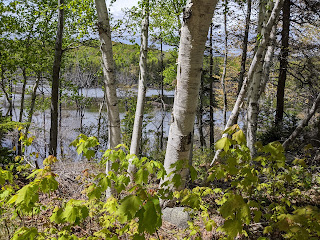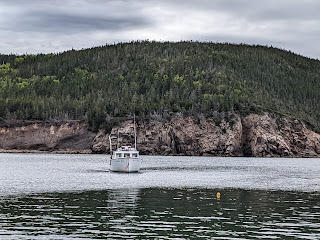I don't think Steven and I had ever stayed at a more beautiful B&B than at Acres Woods in Ingonish, Nova Scotia. Not only was our room and en suite large, but the views were also lovely from each window, the breakfast was filling and delicious, and the hosts did everything to make us feel welcome!
The approach to the nearby Cape Breton Highlands National Park which was established in 1936:
The town of Ingonish was at the entrance to the park which was known for its spectacular highlands and ocean scenery. The highlands, known as the Cape Breton Plateau, cover the majority of northern Cape Breton. A third of the world-famous Cabot Trail scenic highway runs through the national park over the highlands and along the coasts. The park's cool maritime climate and rugged landscape allowed for a unique blend of Acadian, Boreal, and Taiga habitats, plants, and animals. The mix of Boreal and temperate species cannot be found anywhere else in Canada.
Lina: I wonder if you and Dan hiked the Middle Head Trail on your honeymoon? You may recall the trail followed a long, narrow peninsula separating two ocean bays before ending on cliffs overlooking the Atlantic, Cape Smokey, and Ingonish Island. We hoped we might catch sight of some seals, whales, and eagles while hiking.
Cattle once rambled down this trail pausing to drink at the trough nearby.
When the trail opened up, the views were spectacular on both sides.
Over half a dozen families had fish shacks here and lobster was sold from May to July until the 1990s. Then, salmon and fish traps became scarce as did cod. It was so sad to read that these former fishing communities could no longer exist without fishing. "Our children, our homes, our music, our culture depend on catching fish in the ocean."
Later, I checked at the park's Visitor Center what these warty nodules were and was told they were burls and had occurred when pathogens or other injuries damaged the trees. Only certain trees were susceptible to the burls, I learned.
We turned around at the end of the peninsula after spotting the seagulls and the iconic red chair, a feature of parks in Atlantic Canada.
The lovely Keltic Lodge inside the national park was on land where inventor and nearby resident Alexander Graham Bell and a friend roamed in the 1890s.
Beyond the lodge was Freshwater Lake Loop which was more restful as it had far fewer hikers on it. The trail followed the shore of a small lake that used to be a bay.
It was a little cool to think about sitting on the beach!
Across the bay was the Keltic Lodge and ...
the tip of the peninsula we'd just hiked.
The cobble barrier beach separated the lake from the ocean. It was so calming hearing the pounding waves as they hit the small, smooth cobbles.
Since growing up on Birch Avenue in Ottawa, Canada, the trees have always had a special affinity for me.
St. Peter's Church in Ingonish celebrated its centennial in 2013.
Leaving Ingonish, we drove north and stopped at Lakies Head to take in the beautiful view.
We didn't seals, whales, or even northern gannets which were supposed to be very common in this area - nada, zip!
Nor did we see any moose - the closest was this sign!
We took advantage of being close to Jack Pine Trail, a loop trail overlooking the Atlantic coastline that wound through a stand of jack pine trees that was separated from the rest of its range by an astonishing 125 miles!
Seeing another of the red chairs in such a dreamy spot made me smile!
The trail led to Black Brook Beach and Still Falls.
Since a fire scorched two acres of this rocky coastline in September of 2002, researchers have been working to understand the relationship between fires and forests.
The jack pine forest was slowly becoming a spruce-fir forest because millions of spruce and fir seeds are released every year while jack pine seeds remain in tightly closed cones. In addition, jack pines need full sunlight to grow well unlike spruce and fir which blossom in forest shade.
These grooves recorded the path of highland boulders that had been dragged seaward beneath glacial ice. As the granite bedrock slowly moved, fractured rock that was left behind became rocky soil. the rounded boulders that were dumped at the ocean's edge in time became cobble beaches.
This jack pine stand has been declared a heritage tree stand because it had the only upright jack pines in Cape Breton.
I read that the color in the streams in Cape Breton and tea is due to tannic acid that has been released from plant remains. The froth was produced when "aerated acidic stream water combines with iron dissolved from the rocks."
Further north along the Cabot Trail, but just outside of the national park, was the community of Neil's Harbour.
We watched vicariously for a few minutes as a group of fellow tourists clad in rain gear and life jackets got into a zodiac to go whale watching. I hope they had more success than we had had to spot some wildlife that day.
A few feet from the harbor was the town's heritage lighthouse.
A lighthouse anyone?!
This barrel-style of trash container was the norm in most of the communities. I figured it must have been to keep bears away from the trash.
St. Andrew's Anglican Church was at the end of the road in Neil's Harbour.
One picturesque village after another dotted the Cabot Trail. This was Hatchers Point.
By far the poorest hamlet we'd seen so far on the trail was White Point at the tip of the peninsula on Aspy Bay. The fishing community was located on the Coastal Route which was north of the Cabot Trail which had veered inland at Neil's Harbour.
Knowing how dire the fishing industry had become in many spots in the province, I wondered how many fish this boat had caught that June day.
Continuing along the Coastal Route for a bit, we reached postcard-pretty Scotch Cove. Were we ever happy we'd chosen to detour from the much-ballyhooed Cabot Trail as we found these views drop-dead gorgeous!
A little sadly, the Coastal Route ended at South Harbour where it met up with the Cabot Trail which we took back to our perfect hideaway in Ingonish.
Next post: Venturing further along the Cabot Trail and the national park to the Gulf of St. Lawrence on the west side of Cape Breton.
Posted on August 19th, 2022, a day after finally getting home to Denver from our 13,000-plus mile road trip that we began in May. It's wonderful sleeping in our own bed and knowing where the bathroom is in the middle of the night and not having to pack and unpack every few days!
























































































The Cabot Trail is on our list. We enjoyed the post!
ReplyDeleteYou should go - it's phenomenal. Don't hesitate to let me know if you have any questions I could help with.
ReplyDeleteI loved this post -- the Cabot trail with its endless spectacular vistas, the iconic Red Adirondack chairs always positioned for the most memorable views and the warm hospitality of the Cape Breton hosts. Merci . xo xo Lina xo
ReplyDeleteThanks, Lina, for your kind comments about the epic Cabot Trail. It was a joy to once again drive through Cape Breton after such a long absence.
ReplyDelete